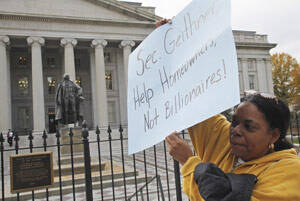The latest U.S. Census Bureau figures indicate a significant turnaround in the nation’s fortunes, with 43.6 million people—about 14.3 percent of the population—who could be characterized as poor last year. In 2008, the year the federal government set the poverty level at $22,025 a year for a family of four, 13.2 percent of the country lived in poverty, just under 40 million people. The increase in 2009 is the second-largest year-to-year uptick since 2004.
“It’s clear there is an enormous amount of suffering out there,” said Fred Kammer, S.J., the executive director of the Jesuit Social Research Institute at Loyola University in New Orleans and one-time president of Catholic Charities USA. “As always happens, it is the poor who are suffering more in hard times, and that’s what we’re seeing with these numbers.” Demographers report the U.S. working-age population was especially hard hit in 2009. About 12.4 percent of Americans aged 18 to 64 were poor—up from 11.7 percent in 2008 and the biggest annual increase since 1965.
Father Kammer thinks Loyola’s neighboring gulf states will be particularly hard hit in 2009. “Our states are always at the bottom of these numbers.” Louisiana may be an exception, Kammer added, as its economy remains artificially pumped up by federal aid related to Katrina rebuilding.
The increase in poverty raises questions about the impact of President Obama’s much-touted $787 billion economic stimulus package. Republicans are using the new poverty figures to charge that the stimulus did not work and to promote deficit reduction and, simultaneously, more tax cuts as a better strategy for solving the nation’s economic woes. But Father Kammer wonders if the 2009 stimulus package just wasn’t large enough to move the country clear of its economic malaise. It could be, he said, that the nation would have been in even worse economic condition without it, but “we didn’t do enough.”
There seems to be little political appetite for more government spending now to address the nation’s rising poverty rate or move more citizens off the unemployment rolls. In fact some analysts have begun to talk of long-term structural unemployment as an inevitable fact of U.S. life in the future.
Father Kammer said that while the last election cycle focused on America’s declining middle class, poverty and unemployment grew among the poorest. While Catholic Charities USA promotes a campaign to reduce U.S. poverty by 50 percent by 2020, Father Kammer said there appears little public support for such antipoverty crusades. “It’s sort of like [Michael] Harrington’s ‘other America,’ that no one sees anymore.”
But changing that perspective could be only a matter of altering what the public perceives as an emergency. The billions of dollars quickly appropriated during the Bush administration for the Troubled Asset Relief Program that bailed out Wall Street and the U.S. banking system indicates that federal money can still be made available in a time of crisis. But does the recent acceleration of U.S. poverty and unemployment warrant crisis-level attention? Father Kammer thinks so. “The investment we made in our banking and our financial institutions is the kind of investment we ought to be making in poor America,” he said, “and we have not. And we don’t seem to have the political will to do so.”








